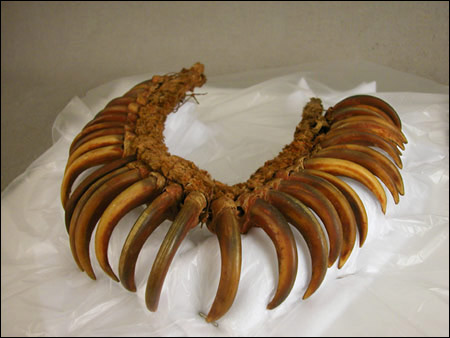Acquisition of Lewis and Clark found at Peabody
American Indian bear claw necklace had been languishing in storage room since 1941

Peabody Museum Director William Fash announced Friday (Jan. 16) that a rare American Indian bear claw necklace acquired by Meriwether Lewis and William Clark during their epic exploration of the American West was discovered in a storage room at the Peabody Museum. “Everyone at the Peabody feels a sense of awe at the power and beauty of this object, and great satisfaction that it will once again be available to enlighten us all about the world from whence it came.”
One of only a half-dozen surviving American Indian objects that can be positively attributed to Lewis and Clark, the necklace had been missing since it was first cataloged in 1899.
David Borlaug, president of the Lewis and Clark Fort Mandan Foundation in North Dakota, and past-president of the National Lewis and Clark Bicentennial Council, said of the new discovery: “This would certainly be the most astounding discovery in some time – I can’t think of anything that would compare. It’s wonderful to have proof that the Lewis and Clark bicentennial really is a ‘voyage of rediscovery’ because there are still things to be discovered 200 years later.”
The necklace, probably given to the explorers by an Indian chief, was discovered during a storage inventory on Dec. 17, 2003. In remarkably good condition, the necklace consists of 38 bear claws, each approximately 3 inches long, attached with rawhide thongs to a fur foundation – possibly weasel. The claws were originally covered with a red pigment, now largely worn away.
According to Gaylord Torrence, curator of Native American art at the Nelson Atkins Museum of Art in Kansas City, and expert in early American Indian artifacts, “Bear claw necklaces, which relate to the bravery and stature of warriors, were treasured by Indian people. They are rare from any time period. The newly discovered bear claw necklace acquired by Lewis and Clark is quite probably the earliest surviving example in the world.”
James Ronda, pre-eminent scholar of Western exploration at the University of Tulsa, called the necklace “an absolutely extraordinary find” and “one of the most significant object finds in recent memory.”
Donated, undonated, returned, and rediscovered
Many of the American Indian objects acquired by Lewis and Clark were given by them and by President Thomas Jefferson to the Peale Museum in Philadelphia, at that time an unofficial national repository.
When the Peale Museum closed in 1848, the Lewis and Clark objects were acquired by the Boston Museum, owned and operated by Moses Kimball. In 1899, the museum suffered severe damage in a fire and was closed. The Kimball family donated 1,400 surviving objects to the Peabody Museum at Harvard, including the Lewis and Clark expedition artifacts. The Kimball family apparently changed their minds and decided to keep the necklace rather than giving it to the Peabody, which had already cataloged it and retained a Peale Museum label describing it.
In 1997, the Peabody Museum launched a new research project focused on the artifacts known as the “Lewis and Clark Collection” in anticipation of the Lewis and Clark Bicentennial. At that time, Associate Curator of North American Ethnography Castle McLaughlin and collections staff conducted an extensive search of the Peabody North American storage area in search of the necklace, without result.
In December 2003, two collections assistants working in the Oceania storerooms on an inventory and cataloging project realized that a necklace they were photographing was incorrectly identified as Oceanic and notified the collections manager.
The acquisition record for the misidentified object indicated that the Kimball family had indeed retained it in 1899, but a descendant then donated the necklace to the Peabody in 1941. At that time, a staff member erroneously cataloged it as an artifact from the South Pacific Islands, and thus it was “lost” in those collections.
Necklace to go on display
The necklace was found just weeks after the Peabody Museum opened a new exhibit on the Lewis and Clark Indian artifacts “From Nation to Nation: Re-examining Lewis and Clark’s Indian Collection.” The exhibit represents years of new research on the objects and is accompanied by a definitive study of the complete Lewis and Clark collection by McLaughlin, titled, “Arts of Diplomacy: Lewis and Clark’s Indian Collection” (University of Washington Press and Peabody Museum Press, 2003). The necklace will be added to the exhibit in the spring.




